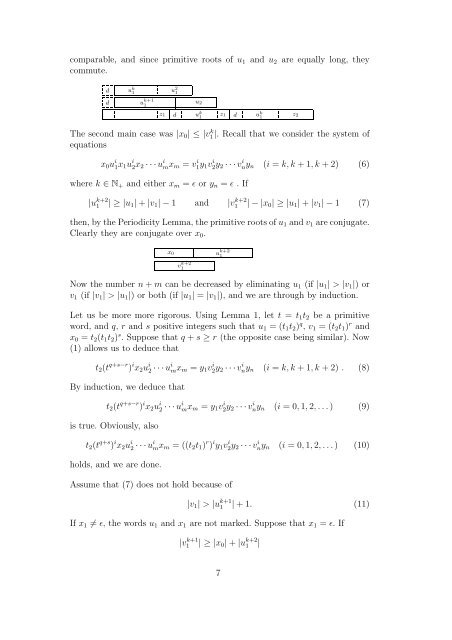On systems of word equations with simple loop sets
On systems of word equations with simple loop sets
On systems of word equations with simple loop sets
You also want an ePaper? Increase the reach of your titles
YUMPU automatically turns print PDFs into web optimized ePapers that Google loves.
comparable, and since primitive roots <strong>of</strong> u 1 and u 2 are equally long, they<br />
commute.<br />
d u k 1 u 2 1<br />
d u k+1<br />
1<br />
u 2<br />
z 1 d u k<br />
1<br />
z 1 d u k<br />
1<br />
z 2<br />
The second main case was |x 0 | ≤ |v k 1|. Recall that we consider the system <strong>of</strong><br />
<strong>equations</strong><br />
x 0 u i 1 x 1u i 2 x 2 · · ·u i m x m = v i 1 y 1v i 2 y 2 · · ·v i n y n (i = k, k + 1, k + 2) (6)<br />
where k ∈ N + and either x m = ǫ or y n = ǫ . If<br />
|u k+2<br />
1 | ≥ |u 1 | + |v 1 | − 1 and |v k+2<br />
1 | − |x 0 | ≥ |u 1 | + |v 1 | − 1 (7)<br />
then, by the Periodicity Lemma, the primitive roots <strong>of</strong> u 1 and v 1 are conjugate.<br />
Clearly they are conjugate over x 0 .<br />
x 0 u<br />
k+2<br />
1<br />
v k+2<br />
1<br />
Now the number n + m can be decreased by eliminating u 1 (if |u 1 | > |v 1 |) or<br />
v 1 (if |v 1 | > |u 1 |) or both (if |u 1 | = |v 1 |), and we are through by induction.<br />
Let us be more more rigorous. Using Lemma 1, let t = t 1 t 2 be a primitive<br />
<strong>word</strong>, and q, r and s positive integers such that u 1 = (t 1 t 2 ) q , v 1 = (t 2 t 1 ) r and<br />
x 0 = t 2 (t 1 t 2 ) s . Suppose that q + s ≥ r (the opposite case being similar). Now<br />
(1) allows us to deduce that<br />
t 2 (t q+s−r ) i x 2 u i 2 · · ·ui m x m = y 1 v i 2 y 2 · · ·v i n y n (i = k, k + 1, k + 2) . (8)<br />
By induction, we deduce that<br />
t 2 (t q+s−r ) i x 2 u i 2 · · ·ui m x m = y 1 v i 2 y 2 · · ·v i n y n (i = 0, 1, 2, . . .) (9)<br />
is true. Obviously, also<br />
t 2 (t q+s ) i x 2 u i 2 · · ·ui m x m = ((t 2 t 1 ) r ) i y 1 v i 2 y 2 · · ·v i n y n (i = 0, 1, 2, . . .) (10)<br />
holds, and we are done.<br />
Assume that (7) does not hold because <strong>of</strong><br />
|v 1 | > |u k+1<br />
1 | + 1. (11)<br />
If x 1 ≠ ǫ, the <strong>word</strong>s u 1 and x 1 are not marked. Suppose that x 1 = ǫ. If<br />
|v k+1<br />
1 | ≥ |x 0 | + |u k+2<br />
1 |<br />
7
















